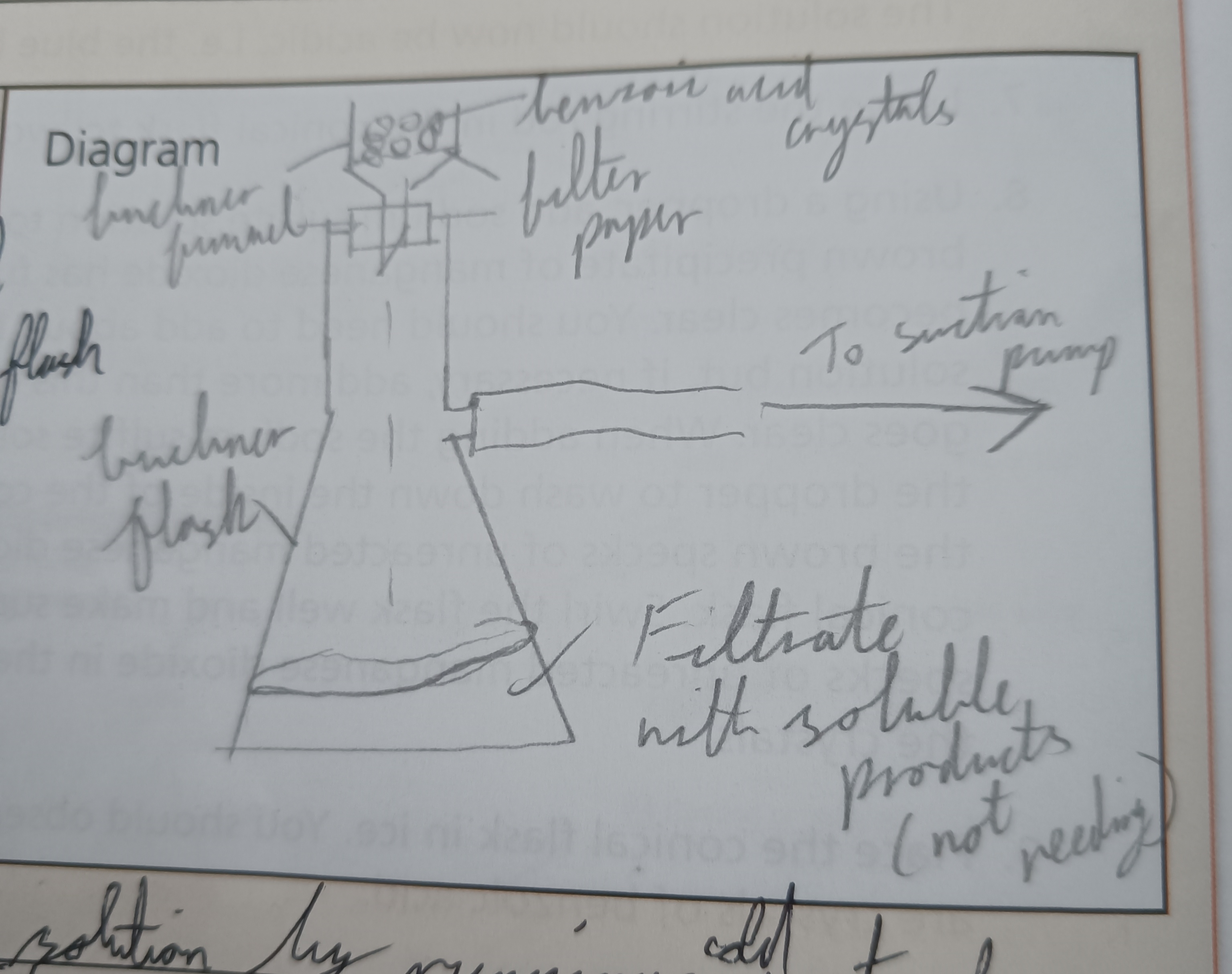Oxidise phenylmethanol to benzoic acid using KMnO4 in alkaline conditions
1/27
There's no tags or description
Looks like no tags are added yet.
Name | Mastery | Learn | Test | Matching | Spaced |
|---|
No study sessions yet.
28 Terms
Draw a diagram of this experiment
…

Step 1
Add phenylmethanol into a conical flask
Step 2
Add saturated potassium permanganate and sodium carbonate
Step 3
Clamp conical flask in a beaker of boiling water for 20 minutes
Step 4
Cool solution by running cold water from the tap over the outside of the conical flask
Step 5
Add hydrochloric acid to help precipitate the benzoic acid crystals in the fume cupboard
Step 6
Dip glass rod into conical flask and touch it against blue litmus paper (Non-acidic)
Step 7
Add sodium sulfite solution until brown precipitate dissapears
Step 8
Stir flask until brown specks of unreacted manganese dioxide disappear
Step 9
Place conical flask in ice
Step 10
White crystals form
Step 11
Filter off crystals using a Buchner flask + filter paper
Step 12
Transfer filtered liquid into conical flask and rinse benzoic crystals
Step 13
Filter solution and rewash crystals
Step 14
Place damp filter paper containing crystals on a clock glass + allow crystals to dry overnight
Step 15
Use electronic balance to record mass of benzoic acid crystals formed
Step 16
Calcculate % yield of benzoic acid
Why should you stir the flask to remove the unreacted specks of manganese dioxide
Contaminate the benzoic acid crystals
What is appearance of phenylmethanol?
Colourless liquid
Why is sodium carbonate added to the reaction mixture?
Ensures an alkaline mixture as this oxidation works best at alkaline pH
Why is a concentrated/saturated solution of potassium permanganate used?
Ensures there is enough potassium permanganate to oxidise all the phenylmethanol to benzoic acid
Why is concentrated hydrochloric acid added to the reaction? (3)
Convert sodium benzoate to benzoic acid. Neutralise excess sodium carbonate and produce potassium hydroxide. Acidic conditions help reduce Mn4+ to Mn2+
Why was it placed in a fume cupboard when concentrated HCL was added?
Concentrated HCL is volatile and toxic if inhaled
Why was sodium sulfite solution added to the reaction?
To reduce insoluble Mn4+ ions to soluble Mn2+ which are filtered out of the benzoic acid crystals
What is observed when sodium sulfite is added to the conical flask? (2)
Brown manganese dioxide precipitate disappears. White crystals of benzoic acid become visible
Suggest a reason as to why a student may have difficutly getting crystals and smelling almonds. How to fix this?
Phenylmethanol hasn't been fully oxidised to benzoic acid as some remained as benzaldehyde. Use excess KMnO4
Why are the crystals washed?
Removes any soluble impurities on the crystals or filter paper
Why does the water used to rinse the crystals have to be ice cold?
Benzoic acid is soluble in warm water